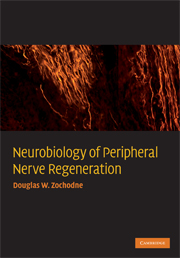Book contents
- Frontmatter
- Contents
- Acknowledgments
- 1 Introduction
- 2 The intact peripheral nerve tree
- 3 Injuries to peripheral nerves
- 4 Addressing nerve regeneration
- 5 Early regenerative events
- 6 Consolidation and maturation of regeneration
- 7 Regeneration and the vasa nervorum
- 8 Delayed reinnervation
- 9 Trophic factors and peripheral nerves
- 10 The nerve microenvironment
- References
- Index
- Plate section
- References
8 - Delayed reinnervation
- Frontmatter
- Contents
- Acknowledgments
- 1 Introduction
- 2 The intact peripheral nerve tree
- 3 Injuries to peripheral nerves
- 4 Addressing nerve regeneration
- 5 Early regenerative events
- 6 Consolidation and maturation of regeneration
- 7 Regeneration and the vasa nervorum
- 8 Delayed reinnervation
- 9 Trophic factors and peripheral nerves
- 10 The nerve microenvironment
- References
- Index
- Plate section
- References
Summary
What kind of reception do regenerating axons or SCs encounter when they enter nerve trunks that have not housed axons for substantial periods of time? Are target organs receptive to reactivation after months or years of denervation? Unfortunately, the structural and molecular consequences of prolonged denervation substantially diminish the likelihood for reinnervation. This chapter deals with delayed reinnervation, a common and all too frequently unavoidable problem in patients.
Clinical scenarios and long-term denervation
There are several reasons why axons may encounter denervated distal stumps or target organs months or years after an injury. The first is obvious. The most optimistic rates of axon recovery range between 1 and 3 mm/day or an inch per month. Many severe human nerve trunk injuries occur in large proximal nerves, such as the sciatic nerve in the thigh or buttock [557] (see Figure 1.2). These lesions rarely allow successful recovery of sensation or motor connections to muscle endplates in the distal leg or foot. In the case of a lesion of the sciatic nerve at the level of the thigh, it would require over a year for axons to regenerate an approximate distance of 800 mm to the foot unimpeded. Moreover, distal portions of the nerve trunk would not receive new axons for many months. This analysis, however, oversimplifies the true scenario that may exist. Estimates of regeneration are based on the time the first axons meet their target, whereas a substantial population of axons must connect to their targets for functional reinnervation.
- Type
- Chapter
- Information
- Neurobiology of Peripheral Nerve Regeneration , pp. 170 - 181Publisher: Cambridge University PressPrint publication year: 2008



